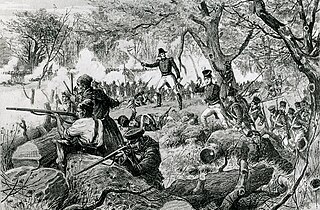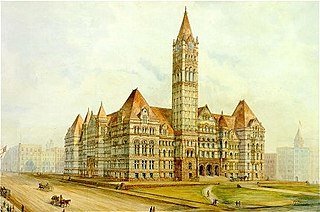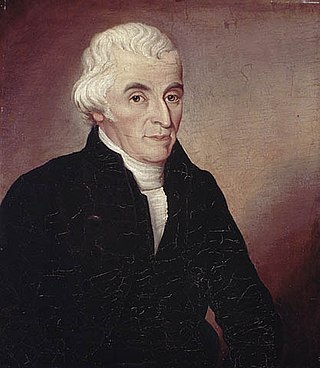
Thayendanegea or Joseph Brant was a Mohawk military and political leader, based in present-day New York and, later, Brantford, in what is today Ontario, who was closely associated with Great Britain during and after the American Revolution. Perhaps the best known Native American of his generation, he met many of the most significant American and British people of the age, including both United States President George Washington and King George III of Great Britain.

The Humber River is a river in Southern Ontario, Canada. It is in the Great Lakes Basin, is a tributary of Lake Ontario and is one of two major rivers on either side of the city of Toronto, the other being the Don River to the east. It was designated a Canadian Heritage River on September 24, 1999.

Ancaster is a historic town in the city of Hamilton, Ontario, Canada, located on the Niagara Escarpment. Founded as a town in 1793, it immediately developed itself into one of the first significant and influential early British Upper Canada communities established during the late 18th century eventually amalgamating with the city of Hamilton in 2001. By 1823, due to its accessible waterpower and location at the juncture of prehistoric indigenous trading routes, Ancaster had become Upper Canada's largest industrial and commercial centre. Additionally, Ancaster had at that time attracted the 2nd largest populace (1,681) in Upper Canada, trailing only Kingston, but surpassing the populations of nearby Toronto (1,376) and Hamilton (1,000). After this initial period of prosperity in the late 18th century, sudden significant water and rail transportation advancements of the early 19th century would soon better benefit Ancaster's neighbouring towns nearer the Lake Ontario waterfront. Stationary steam engines for industries rapidly developing in the 19th century would eventually make Ancaster's water-powered industries less vital. As a result, after the 1820s, Ancaster's influence would begin to wane during the remainder of the 19th century.

Lieutenant-Colonel John Butler was a British Indian Department officer, landowner and merchant. During the American Revolutionary War, he was a prominent Loyalist who commanded Butler's Rangers. Born in New London, Connecticut, he moved to New York with his family, where he learned several Iroquoian languages and worked as an interpreter in the fur trade. He was well-prepared to work with the Mohawk and other Iroquois nations who became allies of the British during the rebellion.

Swansea is a neighbourhood in the city of Toronto, Ontario, Canada, bounded on the west by the Humber River, on the north by Bloor Street, on the east by High Park and on the south by Lake Ontario. The neighbourhood was originally a separate municipality, the Village of Swansea, which became part of Metropolitan Toronto in 1953.
Richard Beasley was a soldier, political figure, farmer and businessman in Upper Canada.
Peter Robinson was a Canadian politician who served as Commissioner of Crown Lands as well as on the Legislative Assembly, Legislative Council, and Executive Council of Upper Canada. He is known for his work in organizing the migration and settlement of what is now Peterborough, Ontario.

When the United States and the United Kingdom went to war against each other in 1812, the major land theatres of war were Upper Canada, Michigan Territory, Lower Canada and the Maritime Provinces of Nova Scotia, New Brunswick, Prince Edward Island and Cape Breton . Each of the separate British administrations formed regular and fencible units, and both full-time and part-time militia units, many of which played a major part in the fighting over the two and a half years of the war.

John Norton or Teyoninhokarawen was a Mohawk chief, Indian Department interpreter and a school master. He was adopted by the Mohawk at about age 30 at their major reserve in Canada. After deserting the British military in the late 18th century, he became a military leader of Iroquois warriors in the War of 1812 on behalf of Great Britain against the United States. Commissioned as a major, he led warriors from the Six Nations of the Grand River into battle against American invaders at Queenston Heights, Stoney Creek, and Chippawa.

John Brant or Ahyonwaeghs was a Mohawk chief and government official in Upper Canada.

The Toronto Purchase was the sale of lands in the Toronto area from the Mississaugas of New Credit to the British crown. An initial, disputed, agreement was made in 1787, in exchange for various items. The agreement was revisited in 1805, intended to clarify the area purchased. The agreement remained in dispute for over 200 years until 2010, when a settlement for the land was made between the Government of Canada and the Mississaugas for the land and other lands in the area.

The Kingston Royal Naval Dockyard was a Royal Navy Dockyard from 1788 to 1853 in Kingston, Ontario, Canada, at the site of the current Royal Military College of Canada.

The Queensway–Humber Bay, known officially as Stonegate–Queensway, is a neighbourhood in the southwest of Toronto, Ontario, Canada. It is located in the southeast area of the former City of Etobicoke.

By the arrangements of the Canadian federation, Canada's monarchy operates in Ontario as the core of the province's Westminster-style parliamentary democracy. As such, the Crown within Ontario's jurisdiction may be referred to as the Crown in Right of Ontario, His Majesty in Right of Ontario, the King in Right of Ontario, or His Majesty the King in Right of Ontario. The Constitution Act, 1867, leaves many functions in Ontario specifically assigned to the sovereign's viceroy, the lieutenant governor of Ontario, whose direct participation in governance is limited by the constitutional conventions of constitutional monarchy.

Fort Toronto, also known as Fort Portneuf, was a French trading post that was located near the mouth of the Humber River in what is now Toronto, Ontario, Canada. It was constructed in 1750 by French military officer Pierre Robineau de Portneuf, who had been instructed to build it to facilitate trade with First Nations in the Pays d'en Haut region of New France.

Provincial Marine was a coastal protection service in charge of the waters in the Great Lakes, the St. Lawrence River and parts of Lake Champlain under British control. While ships of the Provincial Marine were designated HMS, they were operated in more of a coast guard manner than as a full-fledged navy. Most ships of the Provincial Marine were built on the Great Lakes.

Augustus Jones was a North American-born Upper Canadian farmer, land speculator, magistrate, militia captain and surveyor. Jones trained as a surveyor in New York City, and fled as a United Empire Loyalist to Upper Canada. In Upper Canada, he worked as a crown surveyor in the Nassau District, where he quickly rose to the position of Deputy Surveyor General, the highest position in a district of Upper Canada. He occupied that position from 1789 informally, and 1791 formally, until his retirement in 1799. During that time he laid down many of the township boundaries in the Niagara Peninsula and on the north shore of Lake Ontario. He led various teams that cut many of the first sideroads and concession roads into these areas, facilitating their settlement by European and American immigrants. Jones also surveyed the routes for Dundas Street and Yonge Street, and supervised their construction. After his retirement, Jones farmed first in Saltfleet Township, later moving to Brantford and finally an estate outside Paris named Cold Springs, where he died in 1836.

Magasin royal was the generic name given to a trading post under the purview of the King of France. The name also applied specifically to two trading posts that were built during the 18th century for French fur trading near the Humber River in the Pays d'en Haut region of New France, in present-day Toronto, Ontario, Canada. According to Ron Brown, author of From Queenston to Kingston: The Hidden Heritage of Lake Ontario's Shoreline, the fort was "little more than a log cabin", and archeologists considered it "the first non-aboriginal building in the Toronto area".

John Stuart was a Church of England clergyman, missionary, educator, and Loyalist. He is noted for being the first chaplain of the Legislative Council of Upper Canada, for being the first Anglican priest in what is now Ontario, for building the first church in what is now Kingston, Ontario, and for opening the first grammar school in Upper Canada.
Jean-Bonaventure Rousseau was an influential fur trader in New France, and, after its capture by Great Britain, the Province of Canada. His father who also went by the given name Jean, had been a fur trader in the Ohio River valley. His son Jean Baptiste Rousseau started as a fur trader before becoming one of the most important merchants in Upper Canada.
















